Divisions of the Australian House of Representatives
Electoral divisions for the Australian House of Representatives are commonly known as electorates, seats or divisions. There are currently 150 single-member electorates for the Australian House of Representatives.
Apportionment
Section 24 of the Constitution of Australia requires that the total number of members of the Australian House of Representatives shall be "as nearly as practicable" twice as many as the number of members of the Australian Senate.
Section 24 also requires that electorates be apportioned among the states in proportion to their respective populations; provided that each original state has at least 5 members in the House of Representatives, a provision that gives Tasmania higher representation than its population would justify.
The Commonwealth Electoral Act 1918 sets out further provisions.[1] There are also two electorates in both the Australian Capital Territory and the Northern Territory.
Within each state and territory, electoral boundaries are redrawn from time to time in a process known as redistribution. This takes place at least once every 7 years, or when the state's entitlement to the number of members of the House of Representatives changes. Boundaries are drawn by a Redistribution Committee, and apportionment within a state is on the basis of the number of enrolled voters rather than total residents or "population".
The number of enrolled voters in each Division cannot vary by more than 10% from the average across a state or territory, nor can the number of voters vary by more than 3.5% from the average projected enrolment three-and-a-half years into the future. However, due to various reasons, larger seats like Fenner contain more than double the electors of smaller seats like Lingiari.
Divisions are divided into four classes according to population and demographic: inner metropolitan (well-established portions of a state capital city), outer metropolitan (more recently developed portions of a state capital), provincial (divisions made up predominantly of regional cities) and rural.[2]
Naming
The Divisions of the House of Representatives are unusual in that many of them are not named after geographical features or numbered, as is the case in most other legislatures around the world. Most Divisions are named in honour of prominent historical people, such as former politicians (often Prime Ministers), explorers, artists and engineers.
In some cases where a Division is named after a geographical locality, the connection to that locality is sometimes tenuous. For instance, the Division of Werriwa, created in 1901, was named after the Aboriginal word for Lake George in the Canberra region. However, Werriwa has not contained Lake George for many decades, and has steadily moved some 200 km north to the south-western suburbs of Sydney over the past century.
List of Divisions in 2016
The maps below show the Division boundaries as they existed at the Australian federal election, 2016.
New South Wales
 Electoral divisions: Sydney area |
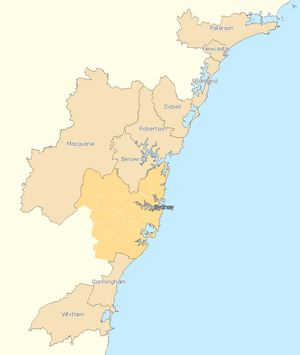 Electoral divisions: Outside Sydney area |
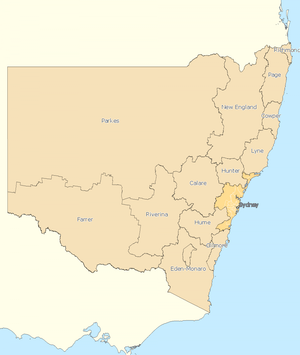 Electoral divisions: Rest of New South Wales |
There are 47 Divisions in New South Wales:
Due to changing demographics, New South Wales lost one seat in the House of Representatives as of the 2016 federal election. The redistribution involved extensive changes to existing boundaries, with approximately 20 per cent of voters in New South Wales being moved into a new electorate. The AEC's initial proposal called for the Division of Hunter to be abolished, with its voters absorbed into the neighbouring electorates of Charlton, New England, and Paterson. Due to the AEC's practice of giving preference to the names of the so-called 'Federation divisions'—those contested at the first federal election in 1901—Charlton was to have been renamed Hunter.[3]
Further, the Division of Throsby was renamed Whitlam, after former Prime Minister Gough Whitlam—part of another AEC practice of honouring deceased Prime Ministers with electoral divisions.[4]
The final map, however, saw Charlton abolished, with Hunter moving eastward to absorb most of Charlton's territory. The name change from Throsby to Whitlam remained in effect.[5]
Victoria
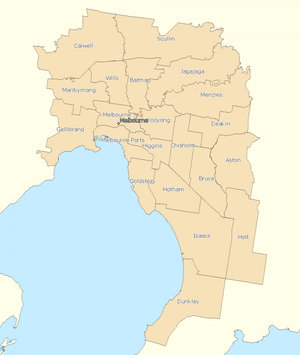 Electoral divisions: Melbourne area |
 Electoral divisions: Outside Melbourne area |
 Electoral divisions: Rest of Victoria |
There are 37 Divisions in Victoria:
Queensland
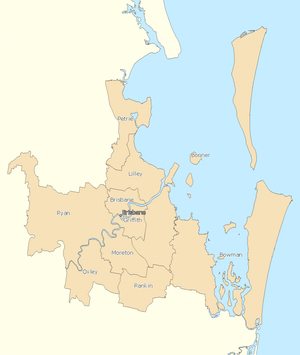 Electoral divisions: Brisbane area |
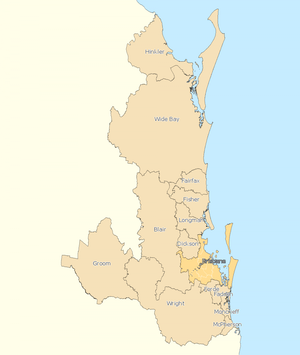 Electoral divisions: Outside Brisbane area |
 Electoral divisions: Rest of Queensland |
There are 30 Divisions in Queensland:
Western Australia
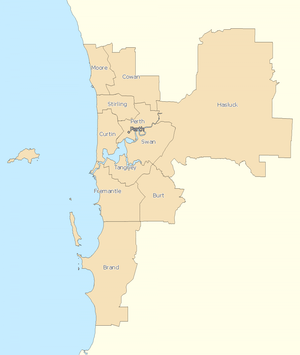 Electoral divisions: Inner Perth area |
 Electoral divisions: Outer Perth area |
 Electoral divisions: Rest of Western Australia |
There are 16 Divisions in Western Australia:
- Brand
- Burt
- Canning
- Cowan
- Curtin
- Durack
- Forrest
- Fremantle
- Hasluck
- Moore
- O'Connor
- Pearce
- Perth
- Stirling
- Swan
- Tangney
Due to Western Australia's growing population, the state gained a 16th seat before the 2016 federal election.[6] The Australian Electoral Commission has named the seat Burt after one of Western Australia's most prominent legal families, and three members thereof in particular:
- Sir Archibald Burt (1810–1879), the first Chief Justice of the Supreme Court of Western Australia,
- Septimus Burt (1847–1919), Attorney-General of Western Australia during the colonial period, and
- Sir Francis Burt (1918–2004), Governor of Western Australia from 1990 until 1993.[7]
Burt is located in the south-eastern suburbs of Perth, and was created out of portions of the neighbouring divisions of Canning, Hasluck and Tangney, and a small portion of Swan.[8]
Based on the results of the 2013 federal election, the new electorate of Burt was notionally a Liberal seat, with a TPP margin of 5.2 percent.[9]
South Australia
 Electoral divisions: Adelaide area |
 Electoral divisions: Rest of South Australia |
There are 11 Divisions in South Australia:
Tasmania
 Electoral divisions: Tasmania |
There are 5 Divisions in Tasmania:
The Territories
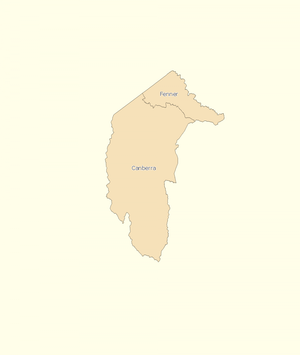 Electoral divisions: Australian Capital Territory |
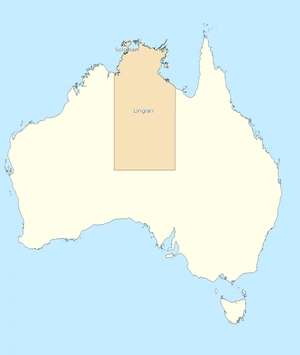 Electoral divisions: Northern Territory |
Australian Capital Territory
There are 2 Divisions in the ACT:
- Canberra
- Fenner (also covers Jervis Bay Territory)
From 1 July 2016, the Division of Canberra also includes voters from Norfolk Island.[10]
Prior to the 2016 federal election, the Division of Fenner was known as the Division of Fraser. The new name honours the Australian virologist Frank Fenner (1914–2010),[11] and the change was due to plans by the Australian Electoral Commission to name a Victorian electorate after former Prime Minister Malcolm Fraser when that state next undergoes an electoral redistribution.[12]
Northern Territory
There are 2 Divisions in the Northern Territory:
- Lingiari (also covers Christmas Island and Cocos (Keeling) Islands)
- Solomon
Abolished Divisions
These Australian Divisions no longer exist:
- Angas (1903–34) (SA)
- Angas (1949–77) (SA)
- Australian Capital Territory (1949–74) (ACT)
- Balaclava (1901–84) (VIC)
- Barrier (1901–22) (NSW)
- Bland (1901–06) (NSW)
- Bonython (1955–2004) (SA)
- Bourke (1901–49) (VIC)
- Burke (1949–55) (VIC)
- Burke (1969–2004) (VIC)
- Canobolas (1901–06) (NSW)
- Charlton (1984–2016) (NSW)
- Cook (1906–55) (NSW)
- Coolgardie (1901–13) (WA)
- Corinella (1901–06) (VIC)
- Corinella (1990–96) (VIC)
- Dalley (1901–69) (NSW)
- Dampier (1913–22) (WA)
- Darebin (1949–69) (VIC)
- Darling (1901–77) (NSW)
- Darling Downs (1901–84) (QLD)
- Darwin (1903–55) (TAS)
- Diamond Valley (1969–84) (VIC)
- Dundas (1977–93) (NSW)
- East Sydney (1901–69) (NSW)
- Echuca (1901–37) (VIC)
- Evans (1949–77) (NSW)
- Fawkner (1906–69) (VIC)
- Fraser (1974–2016) (ACT)
- Grampians (1901–22) (VIC)
- Gwydir (1901–2007) (NSW)
- Hawker (1969–93) (SA)
- Henty (1913–90) (VIC)
- Higinbotham (1949–69) (VIC)
- Hoddle (1949–55) (VIC)
- Illawarra (1901–22) (NSW)
- Isaacs (1949–69) (VIC)
- Kalgoorlie (1901–2010) (WA)
- Laanecoorie (1901–13) (VIC)
- Lang (1901–77) (NSW)
- Lawson (1949–69) (NSW)
- Lowe (1949–2010) (NSW)
- Martin (1922–55) (NSW)
- Mernda (1901–13) (VIC)
- Moira (1901–06) (VIC)
- Namadgi (1996–98) (ACT)
- Nepean (1906–22) (NSW)
- Northern Melbourne (1901–06) (VIC)
- Northern Territory (1922–2001) (NT)
- Oxley (1901–34) (QLD)
- Parkes (1901–69) (NSW)
- Phillip (1949–93) (NSW)
- Prospect (1969–2010) (NSW)
- Riverina-Darling (1984–93) (NSW)
- Scullin (1955–69) (VIC)
- South Australia (1901–03) (SA)
- South Sydney (1901–34) (NSW)
- Southern Melbourne (1901–06) (VIC)
- St George (1949–93) (NSW)
- Streeton (1984–90) (VIC)
- Tasmania (1901–03) (TAS)
- Throsby (1984–2016) (NSW)
- Watson (1934–69) (NSW)
- West Sydney (1901–69) (NSW)
- Wilmot (1903–84) (TAS)
- Wimmera (1901–77) (VIC)
- Yarra (1901–69) (VIC)
See also
- For a list of members of the current House of Representatives and the electorates they represent, see List of members of the Australian House of Representatives.
- For a description of how the House of Representatives is elected, see Australian electoral system.
External links
- For an electoral history of each Division since Federation in 1901, see Adam Carr's Electoral Archive: Index of House of Representatives Divisions 1901–2001
References
- ↑ Australian Electoral Commission.Research Report 4 – Australian Federal Redistributions 1901–2003. Accessed 5 May 2008.
- ↑ Demographic Classification of Divisions
- ↑ http://www.theguardian.com/australia-news/2015/oct/16/labors-joel-fitzgibbon-loses-seat-under-proposal-to-redraw-boundaries
- ↑ http://www.theguardian.com/australia-news/2015/oct/16/labors-joel-fitzgibbon-loses-seat-under-proposal-to-redraw-boundaries
- ↑ http://blogs.abc.net.au/antonygreen/2016/03/2016-federal-election-pendulum-update.html
- ↑ http://www.aec.gov.au/Electorates/Redistributions/2014/wa/proposed-report/files/proposed-report.pdf
- ↑ http://www.aec.gov.au/Electorates/Redistributions/2014/wa/proposed-report/files/proposed-report.pdf
- ↑ http://www.aec.gov.au/Electorates/Redistributions/2014/wa/proposed-report/files/proposed-report.pdf
- ↑ http://www.abc.net.au/news/wa-federal-redistribution-2015/
- ↑ "Norfolk Island Electors". Australian Electoral Commission. 23 May 2016. Retrieved 18 June 2016.
- ↑ http://www.abc.net.au/news/2016-01-28/electorate-of-canberra-creeps-north-to-encompass-inner-city/7122282
- ↑ http://aec.gov.au/Electorates/Redistributions/2014/act/proposed-report/files/proposed-report.pdf
